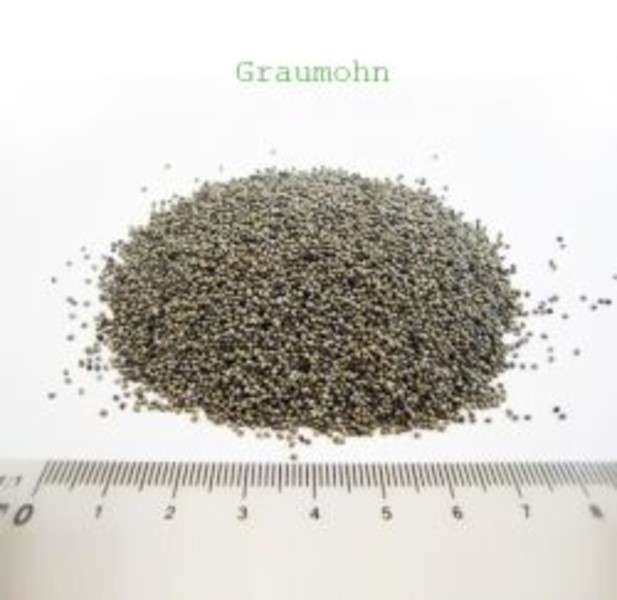
Poppy seed oil
Oil extraction
Poppy seed oil is obtained from the seeds of Papaver somniferum by mechanical pressing. A distinction is made between cold and hot pressing. In both pressing methods, the poppy seed is first cleaned and dried, then added to a screw press.
A Florapower oil press can be used for cold and warm pressing of poppy seeds.
Cold pressing yields a higher-quality oil, suitable mainly for edible purposes, while hot pressing at 60-70˚C yields a somewhat inferior oil, used mainly for technical purposes and paint production [Bauer 1928, p. 207]. Another production option is that of extraction with supercritical CO2 (Bozan/Temelli 2003).
A possible problem was the blending of high-quality poppy seed oil with much cheaper sunflower oil. Such a blend was therefore almost impossible to detect using conventional methods, since the fatty acid compositions of these two oils are almost identical. A novel method, using SPME-GC-MS analysis to analyze the volatile components of the oil, makes it possible to detect even the smallest amounts of sunflower oil in poppy seed oil in an unambiguous manner [Krist et al. 2006 [3]].
Use
Pharmaceutical and medical uses
Poppy seed oil, having a mild scent and being absorbed very quickly into the skin, is used in the manufacture of liniments, ointments, and emulsions [Hackbarth 1944, pg. 120]. A further potential application is in the area of chemotherapy: Iodized poppy seed oil is injected into the hepatic artery, then accumulates in microdrops only in the tissue containing hepatocellular carcinoma, where it remains over three weeks and attacks the tumor cells [Battacharya et al. 1994, Krist et al. 2005 – Higashi/Setoguchi 2000]. The iodized products of poppy seed oil’s fatty acid ethyl esters, being X-ray contrast mediums, are used in sonography, lymphangiography, and paranasal sinus imaging [Choi et al. 1989, Krist et al. 2005 – Burger/Wachter 1993, 7. Auflage, pg. 1045]. Iodized poppy seed oil can be administered in cases of iodine deficiency, and is also used as a diagnostic aid in sonography, hysterosalpingography, and angiography [Benmiloud et al. 1994, Furnee et al. 1998].
Cosmetic use
In cosmetics, warm-pressed poppy seed oil is used in soap production, where it can very easily create hard soaps [Janystin 1978, pg. 622; Hackbarth 1944, pg. 120]. Poppy seed oil is absorbed rapidly into the skin, replenishing lipids and increasing the skin’s elasticity –features which also make it a component in care products such as anti-wrinkle creams, body lotions and balms; as well as suitable for dry skin. Poppy seed oil is also used as massage oil [Martindale 1993, pg. 1404].
In the kitchen
Due to its interesting and aromatic flavor, cold-pressed poppy seed oil is used as high-quality cooking oil. Its high unsaturated fatty acid content allows it to also lower elevated cholesterol levels. Poppy seed oil should, however, not be heated to temperatures exceeding 170˚C, which means it is only suitable for frying and baking under certain conditions. Poppy seed oil’s chief use is especially in cold foods – in refining salads and cold dishes, crudités, desserts, and müsli. Because of its delicate nutty flavor, poppy seed oil is used to refine sweet dishes such as poppy seed noodles, poppy seed pies, and poppy seed cake. The oil functions as a flavor carrier, thereby enhancing the flavor of the dish itself.
In painting
Poppy seed oil, due to its drying capacity, is well-suited as a basic material in artist’s paint production. Unfortunately, however, poppy seed oil disintegrates and softens at high temperatures, as well as dissolves when exposed to chemical reagents. These disadvantages can be overcome, however, by using a so-called stand oil. This is produced by heating the poppy seed oil in a carbon dioxide current at 250–260˚C for 60 hours. Today, poppy seed oil and linseed oil are among the oils most widely used in the manufacture of artist’s paints. Poppy seed oil, in contrast to linseed oil, is less likely to yellow and also has a more stable plasticity; yet poppy seed oil is somewhat more sensitive to processing. Poppy seed oil best suited for painting is taken from white poppy seeds. Poppy seed oil paints should not be applied to overly greasy, non-absorbent surfaces [Hackbarth 1944, pg. 120].
Industrial use
Since poppy seed oil possesses qualities similar to those of linseed oil and is absorbed quickly, it is also used for wood care and leather care in the furniture industry.
We will be happy to advise you on this seed and show you options. Contact us
In addition to their own knowledge acquired through press trials, the following sources were used to create the article:
- Öle, natürlich kaltgepresst, Basiswissen & Rezepte, Marcus Hartmann, Hädecke, 2008
- Heilende Öle, Pflanzenöle als Nahrungs- und Heilmittel, Neue Erkenntnisse, Günter Albert Ulmer Verlag Tuningen
- Lexikon der pflanzlichen Fette und Öle, Krist, Buchbauer, Klausberger, SpringerWienNewYork, 2008
- www.wikipedia.de
- en.wikipedia.org

